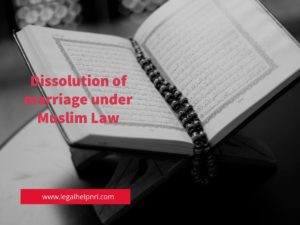
Marriage under the Muslim law can be dissolved by the Husband in the form of Talaq and or by the wife in the form of Khula or by mutual consent of the parties i.e. Mubarat. The types of divorce under the Islamic law are detailed further.

JUDICIAL DIVORCE
Back in the 1930’s, under this personal law a wifecould not divorce except on insanity, impotency or adultery, insanity of the husband. However, the Act of 1939 made provisions whereby the wife could seek divorce on the following grounds:
-
- Whereabouts of the husband have not been known for four years;
- Husband has neglected or failed to provide for for a period of two years;
- Husband has been sentenced to imprisonment for a period of seven years or upwards;
- Husband has failed to perform , without reasonable cause , his marital obligations for a period of three years;
- Husband was impotent at the time of the marriage and continues to be so;
- Husband has been insane for a period of two years or is suffering from leprosy or a virulent venereal disease;
- That she, having been given in marriage by her father or other guardian before she attained the age of fifteen years, repudiated the marriage before attaining the age of eighteen years:Provide that the marriage has not been consummated;
- Husband treats her with cruelty.
EXTRA JUDICIAL DIVORCE
The Islamic Law gives the husband more rights than the wife. The following forms of extra judicial divorce have been described as under:

MODES OF DIVORCE BY HUSBAND
TALAQ
Talaq is dissolution of marriage by the husband, using appropriate words for divorcing his wife without giving any ground.
The differentiation is very much established under the two schools i.e. the Sunni and Shia Law. In the former school a Talaq is acceptable whether done verbally or in writing. Anything which clearly denotes the intention to dissolve the marriage is accepted. It need not be made in the presence of the witnesses.
Oral pronouncement in the presence of two witnesses is the requirement under the latter school. The oral pronouncement is further divided in Talaq-i-sunnat and Talaq- ul -biddat. Talaq-i-sunnat has two forms Ahasan and Hasan. In Ahasan, the divorce is pronounced in the period of tuhr (period between two menstruations) and the husband has no sexualintercourse during the period of iddat. However, if the husband cohabits with his wife in the period of iddat, the divorce stands revoked. In Hasan, the husband must pronounce the divorceduring three successive tuhrs, three times. No cohabitation must take place during this period of Tuhrs.
DIVORCE BY WIFE
TALAQ-I-TAFWEEZ
This form is recognized under both the schools. The power of pronouncing divorce is delegated by the husband to his wife or any other person.
LIAN: where the husband. The act of the husband where he alleges the wife of adultery, her character and the wife disproves the allegations; she has then the right to file for divorce.
KHULA: It is a form of divorce where the wife gives consideration to the husband for his consent and agrees to relinquishthe Mahr in part or entirely.
MUTUAL DIVORCE
MUBARAT: This is the form where both the parties mutually consent and agree to dissolve the marriage and separate.
